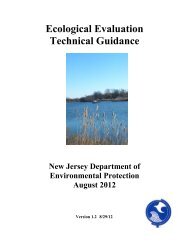Technical and Regulatory Guidance for In Situ Chemical ... - ITRC
Technical and Regulatory Guidance for In Situ Chemical ... - ITRC
Technical and Regulatory Guidance for In Situ Chemical ... - ITRC
You also want an ePaper? Increase the reach of your titles
YUMPU automatically turns print PDFs into web optimized ePapers that Google loves.
ap p roximately 1000 gallons of oxidant solution was injected <strong>for</strong> an average of 25.5 gallons per<br />
injection point. The complete injection program took place in one day.<br />
Operational Per<strong>for</strong>mance<br />
Forty-eight days after injection, all of the monitoring wells at the site were purged <strong>and</strong> resampled,<br />
<strong>and</strong> the same suite of analytes as per<strong>for</strong>med prior to the injection was run by the same analytical<br />
laboratory. The results <strong>for</strong> MW-8 indicated a 35% decrease in benzene concentrations, from 2300<br />
to 1500 ppb. However, concentrations of toluene, ethylbenzene, xylenes, <strong>and</strong> naphthalene increased<br />
by amounts ranging from 69% to 560%. A similar pattern was found at the next most contaminated<br />
well, with benzene <strong>and</strong> naphthalene concentrations decreasing somewhat <strong>and</strong> the remaining<br />
contaminants’ concentrations increasing. At more distant, less contaminated wells, effects were<br />
mixed, but the overall changes in concentration were relatively small.<br />
Problems<br />
As indicated by the comparison of analytical results from be<strong>for</strong>e <strong>and</strong> after treatment, injection of the<br />
oxidant solution did not significantly reduce the overall contaminant concentrations in the<br />
groundwater. NMED believes that, due to the injection of oxidant above the water table, some degree<br />
of soil washing or flushing occurred which removed adsorbed contaminants or free product from the<br />
vadose zone <strong>and</strong> delivered it to the groundwater. The additional mass of contaminants delivered to<br />
t he groundwater through this process may have counteracted any reductions in groundwater<br />
concentrations due to oxidation. <strong>In</strong> addition, the rapid introduction of the oxidant solution into the<br />
s<strong>and</strong>y aquifer may have <strong>for</strong>med preferential pathways that allowed the solution to bypass some<br />
volumes of the soil. Finally, the rapid reaction of the oxidant solution with its catalyst, the<br />
contaminants, <strong>and</strong> naturally occurring organic compounds in the soil may have prevented “active”<br />
oxidants from reaching all contaminated areas of the aquifer.<br />
Although NMED purged three to five well volumes from each monitoring well prior to sampling,<br />
the contractor is concerned that the samples taken from the wells were not truly representative of the<br />
overall groundwater concentrations.<br />
Costs<br />
As this pilot project was per<strong>for</strong>med by the contractor in part to gain state acceptance <strong>for</strong> the process,<br />
the true costs were not calculated. However, the reagents are fairly inexpensive, <strong>and</strong> labor costs are<br />
low (one person completed the injection program in one day). Monitoring well installation <strong>and</strong><br />
analytical costs <strong>for</strong> follow-up sampling are expected to account <strong>for</strong> the majority of project costs.<br />
Follow-up Actions<br />
NMED is currently in negotiations with the contractor <strong>for</strong> additional treatment of the area using the<br />
BiOx p rocess. If the effects of soil washing or flushing by the oxidant solution are largely<br />
responsible <strong>for</strong> the observed contaminant concentrations in the groundwater, as is suspected, then<br />
subsequent treatments with this technology should produce more dramatic reductions in groundwater<br />
concentrations as the mass of contaminants in the vadose zone is reduced. Future groundwater<br />
sampling methodology may be modified to deal with concerns about the representativeness of the<br />
samples taken.<br />
Point of Contact<br />
Patrick DeGruyter<br />
New Mexico Environmental Department<br />
(505) 841-9188<br />
B11
















